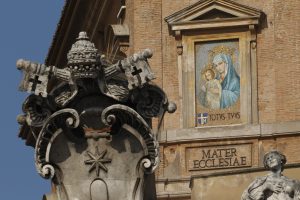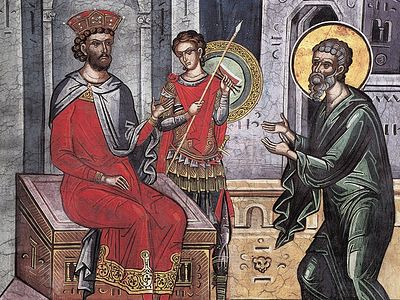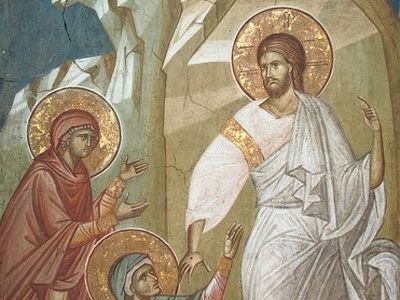 The Myrrh-bearing Women. Artist: Robert Anning Bell
The Myrrh-bearing Women. Artist: Robert Anning Bell
This Sunday is called the Sunday of the Myrrh-Bearing Women; that is, women, bearers of myrrh. Having heard this phrase, “women, bearers of myrrh”, we can suppose that the profession or occupation of these women mentioned by the Holy Evangelists was to anoint the reposed with myrrh; that is, when someone died, they were to anoint with fragrances and aromatic spices the body of the one who had departed to the other world. But we are mistaken! This is not why they are called myrrh-bearers, but because they bore an entirely different myrrh in their hearts—they loved Christ.
Thus, their occupation was not anointing the deceased with fragrances. We can say much more beautiful words about them: The myrrh-bearing women were bearers of the myrrh of love for Christ. And inasmuch as they were bearers of this extraordinary, fearless, beautiful love for Christ, the Church considered it appropriate to dedicate this Sunday almost immediately after the great feast of the Resurrection of Christ, called the Sunday of the Myrrh-bearing Women.
Why have we called the myrrh-bearing women bearers of love? There are a few amazing virtues that we can learn by looking at their relationship to the Lord. Usually when we talk about this Sunday, we underscore the significance of women, and explain the meaning of this wondrous and blessed gift that is woman. And when we immerse ourselves in the stream of modern ideology, we even get the sinful desire to demonstrate woman’s superiority over man, proceeding from the Gospel reading for this Sunday, as if emphasizing these women’s heroism, courage, love, etc. And we would fall into this trap by wishing to prove that women are higher than men, in part due to the fact that they were the first to receive the news of the Resurrection: “Rejoice!” (Matt. 28:9). Perhaps there is a bit of truth in this, but we will never understand the Gospel in this vein.
I think that the myrrh-bearing women attract our attention by other wondrous virtues. First of all, they are bearers of love, who had enormous love for Christ. They did not abandon Him when He was abandoned and left by all, including by the apostles, who knew in some measure just Who Christ was. They saw Him on Mt. Tabor, they knew that He is God, and that they must not abandon Him. They saw Him in all different situations, when Christ worked miracles and healed They saw how He spoke, and understood that no one could ever have spoken or could ever speak as Christ did. This means that the apostles had very weighty reasons why not to abandon the God-Man, their Teacher, when He needed them near Him more than ever.
And Who accompanied Him when He was being insulted, when filthy words were being flung at Him, when people mocked Him and laughed at Him, when He hung alone on the Cross? The myrrh-bearing women. When love is beautiful, authentic, and true, it never abandons a person who has been left alone. To the contrary, a person who loves is ready to follow one who has suddenly found himself alone and in grief—no matter how heavy and dangerous the context of the real circumstances is—and think nothing of it.
The myrrh-bearing women also did this amazing thing. When we meet lonely, abandoned, and unneeded people, let us also learn from the women, the bearers of this myrrh of love, and be close to them.
The words I heard in an interview on a television program with the most worthy Metropolitan Bartholomew (Anani) seared my heart for life. He was asked, “What was the most painful thing in your life?” He replied:
“The most bitter thing for me will always be that my parents died all alone, without comfort, because I was in prison and couldn’t be with them.”
So, when someone dies, you need to be there with him, not leave him alone. You need to hold his hand, stroke his forehead, speak affectionately with him, and be attentive to his every move as he departs from this life. After all, he has become so important and precious to you that you cannot leave him at his moment of death.
Death can also be emotional and spiritual when you are abandoned by all, when everyone is mocking you—deservedly or perhaps undeservedly. But there is another kind of death—loneliness. But if you have a person who truly loves you, you will not be alone.
The second excellent lesson that we can learn from the myrrh-bearing women is that when we truly love God, we receive more than we expect. For here is what love actually means: receiving something of which, as you know in the depths of your soul, you are unworthy. Love is what you will never deserve to receive! You are so unworthy in comparison with the one who loves you so beautifully and abundantly, and you know that you do not deserve to be loved with such strong love as that with which he loves you.
There have been many cases in our lives when each of us as felt conquered by the love we received. Perhaps we expected to be scolded, spat upon, but we received love instead. This is an extraordinary virtue. Why? Because such love possesses enlivening power. And love is always good and tender, and hides a delightful nobility. It never wounds.
The souls of the myrrh-bearing women were torn apart by the sorrows of Passion Friday. They went to seek Christ the crucified, Christ the mocked, Christ the spat upon and tortured… They sought this Christ from early morning in order to perform the appropriate rite over Him Whom they loved. Otherwise, they would not have dared to go out in the dark—after all, at that time there was a patriarchal mentality. Women did not have the same freedoms as they do today. But these women, these bearers of the myrrh of love, ignored all danger.
They could have thought that those guarding the grave would chase them away. But they didn’t think anything of the sort! They had only one thought: to take care of the crucified Christ. And to their great surprise and horror, as the holy evangelists write, they found the tomb empty (in fact, it wasn’t empty—it was filled with the light of Christ’s Resurrection) and they received the tidings that Christ was no longer there! The angel said to them:
“Why seek ye the Living among the dead? He is risen! Go and tell the apostles that they will meet Him in Galilee, as He told them before.”
How excellent, how wondrous is God when you love Him as these myrrh-bearing women did! They thought that they would see Christ dead, crucified on Great Friday. But to their great joy they met Christ resurrected; Him Who conquered death for our sakes and deified our human nature making it just as bright, beautiful, and filled with nobility and with His Resurrection. Only sin spoils and blackens each of us—and how horrible it is to bear the burden of sin.
When you truly love, as did these women, these bearers of the myrrh of love, God always gives you more than you deserve; more than you expect.
And the final thing that we can learn from the myrrh-bearing women, from Mary Magdalene who also goes out early in the morning and sees the grave empty. She meets Someone in the garden where the Christ’s tomb was. And she thinks He is the gardener. She asks Him from a soul darkened with pain:
“Where is the Lord? Perhaps you have taken Him from there and put Him in another place?”
And Christ answers her, but she does not recognize His voice. You see, when we love someone very much, we know every modulation and tone of his voice; these are distinguishing signs for us: “This is the person I love!” The person’s voice means so much to you that as soon as you hear it you feel at peace, and the muddy waters of your soul become clear. But Mary Magdalene did not recognize Him them. She only recognized Christ when He called her by name:
“Mary!”
And she answered with all simplicity:
“Rabboni (Teacher)!”
What can we learn from this? That every time God calls us by name, the name we received at Baptism, we are revived. In the Gospel of John it is said that the sheep know their shepherd by his voice (cf. Jn. 10). We can recognize the Shepherd by His voice only at the moment when He calls us: The Shepherd calls His sheep, He calls them to the Kingdom of God.
When God calls you by name, only then will you recognize God, as it happened with Mary Magdalene.
“And springs well up, sweetly calling us by name.”[1]
This, I think, is what we learn from the women, the bearers of the myrrh of love:
When we love, we do not abandon a person who is alone, sad, and abandoned, when he is experiencing the most acute need for help.
When we love someone very much, we receive much more than we deserve. This is what happened to the myrrh-bearing women who sought Christ as dead, but met Christ Resurrected.
The myrrh-bearing women became the first missionaries of the Risen Christ.
When God calls you, you learn to recognize Him and delve more deeply into Him.
May God help us to emulate these women, these bearers of the myrrh of love, so that each of us might become bearers of Christ’s love!
Pravoslavie.ru
 Photo: sttikhonsmonastery.org
Photo: sttikhonsmonastery.org  St. Tikhon of Moscow’s Gift to AmericaSt. Tikhon’s Monastery is home to a rich history and a great many “treasures” of Orthodoxy, some known, some relatively unknown, which stand as a testament to the prayers and labors of our American apostle, St. Tikhon, and his continuing heavenly protection.
St. Tikhon of Moscow’s Gift to AmericaSt. Tikhon’s Monastery is home to a rich history and a great many “treasures” of Orthodoxy, some known, some relatively unknown, which stand as a testament to the prayers and labors of our American apostle, St. Tikhon, and his continuing heavenly protection.



 Christ’s secret disciplesThis is an example of how people who, as we believe, deserve condemnation for their hypocrisy or cowardice turn out to be even more self-denying and courageous disciples of Christ.
Christ’s secret disciplesThis is an example of how people who, as we believe, deserve condemnation for their hypocrisy or cowardice turn out to be even more self-denying and courageous disciples of Christ. Synaxarion For the Sunday of the MyrrhbearersOn this day, the third Sunday of Pascha, we celebrate the Feast of the Holy Myrrh-Bearing women; and we also commemorate Joseph of Arimathæa, who was a secret disciple, and also Nicodemos, who was a disciple by night.”>myrrh bearing women.
Synaxarion For the Sunday of the MyrrhbearersOn this day, the third Sunday of Pascha, we celebrate the Feast of the Holy Myrrh-Bearing women; and we also commemorate Joseph of Arimathæa, who was a secret disciple, and also Nicodemos, who was a disciple by night.”>myrrh bearing women.  The Life of Saint John ChrysostomThe treasure of treatises and letters which St. John left behind, included the moving sermon that is heard at Easter Sunday services. The loss of his sermons which were not set down on paper is incalculable. Nevertheless, the immense store of his excellent literature reveals his insight, straightforwardness, and rhetorical splendour, and commands a position of the greatest respect and influence in Christian thought, rivaling that of other Fathers of the Church. His liturgy, which we respectfully chant on Sundays, is a living testimony of his greatness.
The Life of Saint John ChrysostomThe treasure of treatises and letters which St. John left behind, included the moving sermon that is heard at Easter Sunday services. The loss of his sermons which were not set down on paper is incalculable. Nevertheless, the immense store of his excellent literature reveals his insight, straightforwardness, and rhetorical splendour, and commands a position of the greatest respect and influence in Christian thought, rivaling that of other Fathers of the Church. His liturgy, which we respectfully chant on Sundays, is a living testimony of his greatness. Is It True That the Will of God Is in Everything?The world lieth in evil not because God wants it, but because sin-loving man wants it.
Is It True That the Will of God Is in Everything?The world lieth in evil not because God wants it, but because sin-loving man wants it.
 Icon of the Mother of God “the Joy of All Who Sorrow”The wonderworking “Joy of All Who Sorrow” Icon of the Mother of God was glorified in the year 1688.
Icon of the Mother of God “the Joy of All Who Sorrow”The wonderworking “Joy of All Who Sorrow” Icon of the Mother of God was glorified in the year 1688.



 Ukrainian hierarch sentenced to 5 years in prisonA hierarch of the canonical Ukrainian Orthodox Church has been sentenced to 5 years imprisonment and the confiscation of property for various supposed crimes against the state.
Ukrainian hierarch sentenced to 5 years in prisonA hierarch of the canonical Ukrainian Orthodox Church has been sentenced to 5 years imprisonment and the confiscation of property for various supposed crimes against the state. 30th anniversary of persecuted abbot of Kiev Caves LavraThe abbot marked the occasion with a Divine Liturgy in the house church where he celebrates the services while the state continues its persecution campaign against him.”>Pavel of Vyshgorod and Abbot of the Kiev Caves Lavra,
30th anniversary of persecuted abbot of Kiev Caves LavraThe abbot marked the occasion with a Divine Liturgy in the house church where he celebrates the services while the state continues its persecution campaign against him.”>Pavel of Vyshgorod and Abbot of the Kiev Caves Lavra,  UOC’s Metropolitan Luke of Zaporozhye placed under nighttime house arrestMet. Luke emphasized that he is being attacked for an ecclesiastical position, not for anything political, as he prays for Ukraine and its authorities and army at every service.”>Luke of Zaporozhye and Melitopol,
UOC’s Metropolitan Luke of Zaporozhye placed under nighttime house arrestMet. Luke emphasized that he is being attacked for an ecclesiastical position, not for anything political, as he prays for Ukraine and its authorities and army at every service.”>Luke of Zaporozhye and Melitopol,  Another Ukrainian hierarch hospitalized under pressure of state persecutionThe canonical hierarch spent eight months last year in round-the-clock house arrest, and is still under nighttime house arrest.”>Theodosy of Cherkasy and Kanev,
Another Ukrainian hierarch hospitalized under pressure of state persecutionThe canonical hierarch spent eight months last year in round-the-clock house arrest, and is still under nighttime house arrest.”>Theodosy of Cherkasy and Kanev,  UOC bishop-abbot faces years in prison for sermon mentioning roadblocks, monastic brotherhood respondsThe Ukrainian Security Service (SBU) detained His Eminence Metropolitan Arseny of Svyatogorsk, the abbot of the Holy Dormition-Svyatogorsk Lavra, yesterday. According to a court ruling, he is to be held in a pre-trial detention center for 60 days without the possibility of bail.”>Arseny of Svyatogorsk,
UOC bishop-abbot faces years in prison for sermon mentioning roadblocks, monastic brotherhood respondsThe Ukrainian Security Service (SBU) detained His Eminence Metropolitan Arseny of Svyatogorsk, the abbot of the Holy Dormition-Svyatogorsk Lavra, yesterday. According to a court ruling, he is to be held in a pre-trial detention center for 60 days without the possibility of bail.”>Arseny of Svyatogorsk,  Persecuted Metropolitan Longin detained at checkpoint following another surgeryThe sickly and much persecuted Metropolitan Longin of Bancheny, one of the staunchest hierarchs of the canonical Ukrainian Orthodox Church, was subject to harassment by Ukrainian officials again this week.”>Longin of Bancheny, and many other bishops and clergymen together with their faithful and steadfast flock. All our aforementioned brothers suffer unjustly, in fabricated and utterly false judicial processes and accusations, imprisonments, physical assaults, deprivation of places of worship, and every other denial of basic human rights.
Persecuted Metropolitan Longin detained at checkpoint following another surgeryThe sickly and much persecuted Metropolitan Longin of Bancheny, one of the staunchest hierarchs of the canonical Ukrainian Orthodox Church, was subject to harassment by Ukrainian officials again this week.”>Longin of Bancheny, and many other bishops and clergymen together with their faithful and steadfast flock. All our aforementioned brothers suffer unjustly, in fabricated and utterly false judicial processes and accusations, imprisonments, physical assaults, deprivation of places of worship, and every other denial of basic human rights.  Hieromartyr Sabbas (Trlaich), Bishop of Gornji KarlovacThe bishop and the priests were told that they were undesirables and that they must abandon their flocks. The Roman Catholic Archbishop of Zagreb, Aloysius Stepinac, openly told Vladyka that he must leave ‘Croatian’ Karlovac, otherwise he would be liquidated. Vladyka answered him: ‘Even if it costs me my head, I will not abandon my people!’ Soon it became clear that the Catholic Archbishop was not joking. Vladyka Sabbas was arrested and horribly tortured. During the tortures and beatings in Plashkom, the Ustashi used a gramophone to play the hymn, ‘As many as have been baptized in Christ, have put on Christ’.
Hieromartyr Sabbas (Trlaich), Bishop of Gornji KarlovacThe bishop and the priests were told that they were undesirables and that they must abandon their flocks. The Roman Catholic Archbishop of Zagreb, Aloysius Stepinac, openly told Vladyka that he must leave ‘Croatian’ Karlovac, otherwise he would be liquidated. Vladyka answered him: ‘Even if it costs me my head, I will not abandon my people!’ Soon it became clear that the Catholic Archbishop was not joking. Vladyka Sabbas was arrested and horribly tortured. During the tortures and beatings in Plashkom, the Ustashi used a gramophone to play the hymn, ‘As many as have been baptized in Christ, have put on Christ’.
